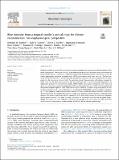Files in this item
Blue intensity from a tropical conifer’s annual rings for climate reconstruction : an ecophysiological perspective
Item metadata
| dc.contributor.author | Buckley, Brendan M. | |
| dc.contributor.author | Hansen, Kyle G. | |
| dc.contributor.author | Griffin, Kevin L. | |
| dc.contributor.author | Schmiege, Stephanie | |
| dc.contributor.author | Oelkers, Rose | |
| dc.contributor.author | D’Arrigo, Rosanne D. | |
| dc.contributor.author | Stahle, Daniel K. | |
| dc.contributor.author | Davi, Nicole | |
| dc.contributor.author | Nguyen, Tran Quoc Trung | |
| dc.contributor.author | Le, Canh Nam | |
| dc.contributor.author | Wilson, Rob J. S. | |
| dc.date.accessioned | 2018-04-30T15:30:10Z | |
| dc.date.available | 2018-04-30T15:30:10Z | |
| dc.date.issued | 2018-08 | |
| dc.identifier | 252900030 | |
| dc.identifier | 87a4eb54-6e16-4e5c-97e2-8703f8c4d122 | |
| dc.identifier | 85046141599 | |
| dc.identifier | 000438755400002 | |
| dc.identifier.citation | Buckley , B M , Hansen , K G , Griffin , K L , Schmiege , S , Oelkers , R , D’Arrigo , R D , Stahle , D K , Davi , N , Nguyen , T Q T , Le , C N & Wilson , R J S 2018 , ' Blue intensity from a tropical conifer’s annual rings for climate reconstruction : an ecophysiological perspective ' , Dendrochronologia , vol. 50 , pp. 10-22 . https://doi.org/10.1016/j.dendro.2018.04.003 | en |
| dc.identifier.issn | 1125-7865 | |
| dc.identifier.other | RIS: urn:62B10BBA10CD6A429A84643CF47C40F4 | |
| dc.identifier.other | ORCID: /0000-0003-4486-8904/work/59953614 | |
| dc.identifier.uri | https://hdl.handle.net/10023/13264 | |
| dc.description | This research was funded by the National Science Foundation of the USA research grants AGS 12-03818 and AGS 13-03976, with additional funding from the Lamont-Doherty Earth Observatory’s Climate Center and Climate and Life initiatives. | en |
| dc.description.abstract | We developed Blue Intensity (BI) measurements from the crossdated ring sequences of Fokienia hodginsii (of the family Cupressaceae) from central Vietnam. BI has been utilized primarily as an indirect proxy measurement of latewood (LW) density of conifers (i.e., LWBI) from high latitude, temperature-limited boreal forests. As such, BI closely approximates maximum latewood density (MXD) measurements made from soft x-ray. The less commonly used earlywood (EW) BI (EWBI) represents the minimum density of EW and is influenced by the lighter pixels from the vacuoles or lumens of cells. The correlation of our BI measurements with climate, strongest for EWBI, rivals that for total ring width (RW), and we demonstrate that it can be successfully employed as an independent predictor for reconstruction models. EWBI exhibits robust spatial correlations with winter and spring land temperature, sea surface temperature (SST) over the regional domain of ENSO, and the Standardized Precipitation Evapotranspiration Index (SPEI) over Indochina. However, in order to mitigate the effects of color changes at the heartwood – sapwood boundary we calculated ΔBI (EWBI-LWBI), and it too exhibits a significant (p < 0.05), temporally stable response to prior autumn (Oct-Nov) rainfall and winter (December to April) dry season temperature. We interpret this response as reflecting a potential cavitation defense by reducing lumen diameter as a means to safeguard hydraulic conductivity in the stem, and to prevent the xylem from imploding due to negative pressure. This study has wide implications for the further use of BI from the global tropics, though it is unclear how many tropical tree species will be appropriate for use. It seems very likely that other wood anatomical measurements can be combined with BI and RW for climate reconstruction. | |
| dc.format.extent | 13 | |
| dc.format.extent | 5872043 | |
| dc.language.iso | eng | |
| dc.relation.ispartof | Dendrochronologia | en |
| dc.subject | Blue intensity | en |
| dc.subject | Tropical dendrochronlogia | en |
| dc.subject | Fokienia hodginsii | en |
| dc.subject | Vietnam | en |
| dc.subject | Dendroclimatology | en |
| dc.subject | Monsoon climate | en |
| dc.subject | GE Environmental Sciences | en |
| dc.subject | NDAS | en |
| dc.subject | SDG 15 - Life on Land | en |
| dc.subject.lcc | GE | en |
| dc.title | Blue intensity from a tropical conifer’s annual rings for climate reconstruction : an ecophysiological perspective | en |
| dc.type | Journal article | en |
| dc.contributor.institution | University of St Andrews. School of Earth & Environmental Sciences | en |
| dc.contributor.institution | University of St Andrews. Scottish Oceans Institute | en |
| dc.contributor.institution | University of St Andrews. St Andrews Sustainability Institute | en |
| dc.identifier.doi | https://doi.org/10.1016/j.dendro.2018.04.003 | |
| dc.description.status | Peer reviewed | en |
This item appears in the following Collection(s)
Items in the St Andrews Research Repository are protected by copyright, with all rights reserved, unless otherwise indicated.

